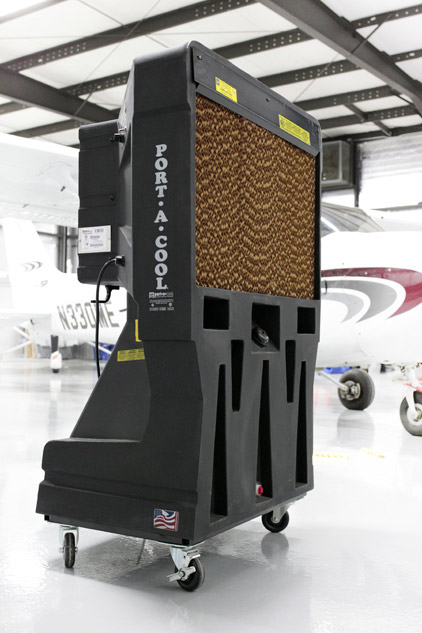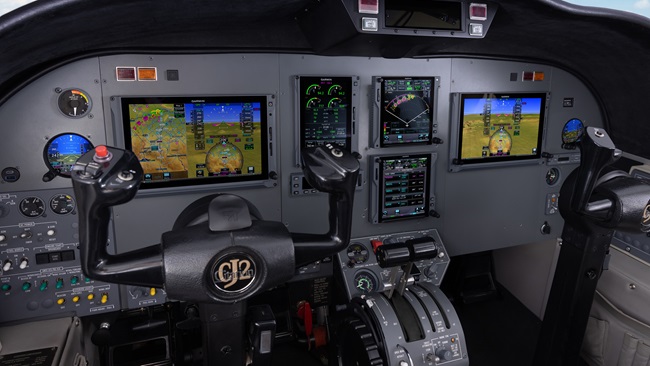Portacool evaporative cooler
Hangars are notorious sweat boxes. They lack insulation, a proper cooling source, and often have terrible ventilation. Unfortunately, there are few options for keeping cool. One of the best is an evaporative cooler.
Flight Outfitters bags
With names like Lift and Thrust, they have to be good

When it comes to certain types of gear, aviation has no shortage of choices. Take flight bags. There are dozens of products, all of which compete against such noble options as the common backpack and bagless-underarm-carry technique. Now we have two more choices with Lift and Thrust, courtesy of new manufacturer Flight Outfitters.
Both bags are well made, with strong zippers, good straps, and robust fabric. Lift has a braided steel handle, which is a bit overkill, albeit quite cool. Styling is modern, with a distinctive black thached pattern with orange striping. Pockets are also nicely designed and abundant, as has become the norm for all new flight bags.
Lift is a fairly standard style of upright bag that holds maybe one headset, a few accessories, and an iPad or charts. My favorite pocket is the little opening on the outside that’s wide enough for an iPad but snug enough to keep it secure. Since I’m in the habit of tossing everything from the airplane into the bag after a flight without organizing it, this is my new favorite shortcut pocket.
Thrust’s styling is more unique. It’s half backpack, half messenger bag and fits nicely on one shoulder or across the chest. There’s a really nice flap on the front that hides more pockets. My one frustration is that the shoulder strap is too long, so the bag sits a bit low. Other than that, it’s a great little pack.—IJT
Contact: www.flightoutfitters.com
Price: Lift is $99.95 and Thrust is $79.95
The PMA450
A real slide-in replacement
By Dave Hirschman

Manufacturer descriptions of their avionics equipment as a “slide-in replacement” should be regarded with deep suspicion—like toys that require “some assembly.” Both tend to be vast understatements.
But if you’re replacing a Garmin GMA 340 audio panel with PS Engineering PMA450, it really is does plug and play. The only tool required is an Allen wrench, and an owner/operator can make the switch himself under FAR Part 43.
The PMA450 eliminates multiple buttons and knobs, adds wireless Bluetooth connections for up to eight devices (and a USB power port for recharging them), and “IntelliAudio,” or directional sound, that helps listeners with stereo headsets differentiate between multiple voice transmissions.
IntelliAudio was developed by the U.S. Air Force and PS Engineering licensed it for general aviation use.
When flying in the left seat, IntelliAudio provides its own version of “surround sound.” Passenger voices sound like they’re coming from behind; the copilot’s voice mostly comes in the right ear, and ATC comes from front-left and front-right.
In real life, that means fewer missed ATC calls. “Say again?”
Only Garmin knows the actual size of the GMA 340 replacement market—but it’s significant since the Kansas firm introduced the popular audio panels in 1997. Garmin is marketing its own upgrade: the GMA 350. The GMA 350 includes new features such as “3D audio” and voice commands, and it sells for $2,195 at Aircraft Spruce.
The GMA 350 is “pin-compatible” with its predecessor, but it’s not a slide-in replacement. This presents an opening for PS Engineering which offers the PMA450 for $1,995 at Aircraft Spruce.
When GMA 340s do get replaced, however, aircraft owners now have more options: scrounge for a used unit (or parts of one), or upgrade to an all-digital audio panel with directional sound.
The factors PS Engineering hopes will tip the balance in its favor are Bluetooth connectivity, and the simplicity of installing and using the PMA450.
If only all slide-in replacements could be this way.
Email [email protected]

Portacool is a leader in evaporative cooling, and it makes a wide range of products. These simple devices have some nice benefits over true air conditioning. They require less power and less maintenance, and the strong fan has an immediate and sustained cooling effect.
Operation is simple. Fill the cooler with water, open the spigot, turn on the pump, and turn on the fan. The 16-inch fan version that we tested runs on a standard outlet and cools an area up to 900 square feet. It also rolls incredibly easily. So if you are doing some maintenance, building an airplane, or just lounging in the hangar, it’s probably all the cooling power you’ll need.
The one major downside to evaporative cooling is that, since it uses the chilling effect of air moving over water, it’s not as effective in humid climates. Users in dry climates can see the mercury drop by double digits, whereas here in swampy Maryland, the effect is muted somewhat. But it still beats a fan.
Contact: www.port-a-cool.com
Price: $1,595



